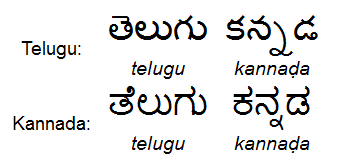Telugu-Kannada script on:
[Wikipedia]
[Google]
[Amazon]
The Telugu–Kannada script (or Kannada–Telugu script) was a writing system used in
 Although the alphabets for Telugu and Kannada languages could have been encoded under a single Unicode block with language-specific fonts to differentiate the styles, they were encoded separately by the governments due to socio-political reasons. Both the script variants were added to the
Although the alphabets for Telugu and Kannada languages could have been encoded under a single Unicode block with language-specific fonts to differentiate the styles, they were encoded separately by the governments due to socio-political reasons. Both the script variants were added to the
Evolution of Telugu-Kannada script
Salankayana Telugu-Kannada script
Kakatiya period Telugu-Kannada inscription
Bayyaram stone inscription
Telugu Script Evolution - Brahmi to Vijayanagara script
Writing systems Brahmic scripts
Southern India
South India, also known as Southern India or Peninsular India, is the southern part of the Deccan Peninsula in India encompassing the states of Andhra Pradesh, Karnataka, Kerala, Tamil Nadu and Telangana as well as the union territories of ...
. Despite some significant differences, the scripts used for the Telugu and Kannada
Kannada () is a Dravidian language spoken predominantly in the state of Karnataka in southwestern India, and spoken by a minority of the population in all neighbouring states. It has 44 million native speakers, and is additionally a ...
languages remain quite similar and highly mutually intelligible. Satavahanas and Chalukyas influenced the similarities between Telugu and Kannada scripts.
History
The Dravidian family comprises about 73 languages including Telugu, Tamil, Kannada, and Malayalam. Satavahanas introduced the Brahmi to present-day Telugu and Kannada-speaking regions. Handbook of Literacy in Akshara Orthography, R. Malatesha Joshi, Catherine McBride (2019), p. 29 But according to Georg Bühler, it seems more likely that the Bhattiprolu script represents a provincial offshoot of early Brahmi in the south, rather than a separate line of development from a hypothetical Semitic prototype itself, as Bühler believed. During the 5th to 7th centuries the early Bādāmi Chālukyās and early Banavasi Kadambās used an early form of the Kadamba script in inscriptions. When Chalukya empire extended towards Telugu speaking regions they established another branch in Vengi, namely the Eastern Chalukyas or the Chalukyas of Vengi who later introduced Kadamba script to Telugu language which developed into the Telugu-Kannada script which was used between the 7th and 11th centuries CE. Between 1100 CE and 1400 CE, the Telugu andKannada
Kannada () is a Dravidian language spoken predominantly in the state of Karnataka in southwestern India, and spoken by a minority of the population in all neighbouring states. It has 44 million native speakers, and is additionally a ...
scripts separated from the Telugu-Kannada script. Both the Telugu and Kannada scripts were standardised at the beginning of the nineteenth century.
Comparison
The following sections visualize the differences between modern-day Telugu (displayed on the ''left'') and correspondingKannada
Kannada () is a Dravidian language spoken predominantly in the state of Karnataka in southwestern India, and spoken by a minority of the population in all neighbouring states. It has 44 million native speakers, and is additionally a ...
letters (displayed on the ''right'').
Consonants
There is another legacy consonant ೞ/ఴ (ḻa) used to represent , but currently not in use.Vowels
Independent vowels
Numerals
Unicode
 Although the alphabets for Telugu and Kannada languages could have been encoded under a single Unicode block with language-specific fonts to differentiate the styles, they were encoded separately by the governments due to socio-political reasons. Both the script variants were added to the
Although the alphabets for Telugu and Kannada languages could have been encoded under a single Unicode block with language-specific fonts to differentiate the styles, they were encoded separately by the governments due to socio-political reasons. Both the script variants were added to the Unicode
Unicode or ''The Unicode Standard'' or TUS is a character encoding standard maintained by the Unicode Consortium designed to support the use of text in all of the world's writing systems that can be digitized. Version 16.0 defines 154,998 Char ...
Standard in October 1991 with the release of version 1.0.
See also
* * Kannada inscriptions * * Linguistic history of the Indian subcontinent * Pallava scriptReferences
CitationsExternal links
Evolution of Telugu-Kannada script
Salankayana Telugu-Kannada script
Kakatiya period Telugu-Kannada inscription
Bayyaram stone inscription
Telugu Script Evolution - Brahmi to Vijayanagara script
Writing systems Brahmic scripts